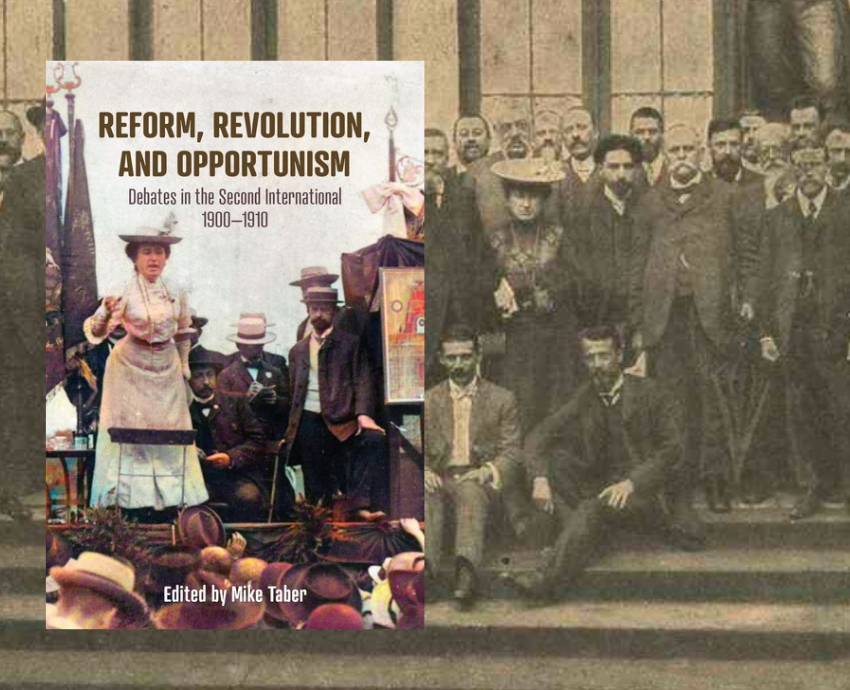
Reform, Revolution, and Opportunism: Debates in the Second International, 1900‒1910
Edited by Mike Taber
Chicago: Haymarket Books, 2023
221 pp
Available as a hardback, paperback and ebook at haymarketbooks.org
What use could there be in translating and compiling socialist resolutions and debates from more than one hundred years ago? Turns out quite a bit.
Formed in 1889, the Second International grouped together socialist parties and trade unions, primarily from Europe and North America but also elsewhere. It originated as a serious attempt to unite the world’s toiling masses into a kind of “world parliament of the working-class movement”, as socialist historian Mike Taber explains in his introduction.
The foundational aim of the Second International was explicitly revolutionary. One of its first resolutions proudly declared: “The emancipation of labor and humanity cannot occur without the international action of the proletariat — organized in class-based parties — which seizes political power through the expropriation of the capitalist class and the social appropriation of the means of production.”
While it championed the fight for reforms such as the 8-hour working day, public education and women’s suffrage, among others, it rejected the idea that capitalism could be reformed. Instead, its stated mission — repeated in resolution after resolution for a quarter of a century — was to overthrow capitalism. Yet, in 1914, the organisation collapsed under the weight of its own contradictions with, as Taber writes, “the main parties of the Second International renounc[ing] past pledges to oppose capitalism’s drive toward war and lin[ing] up behind their respective government’s effort in World War 1”.
In Under the Socialist Banner: Resolutions of the Second International, 1889‒1912, published in 2021, Taber seeks to trace the organisation’s development by translating and collating all its resolutions into one book. In this new collection, he brings to life the discussions that helped shape those resolutions, focusing on five areas of debate.
Each debate has a chapter dedicated to it, with an introductory text by Taber followed by a chronological presentation of the various motions, debates and resolutions adopted at successive gatherings. While obviously occurring in a very different context, these topics — women’s rights, immigration, imperialism, parliamentary tactics and war — continue to be important areas of debate more than a hundred years on.
But beyond the specificities of each debate, what comes through in the collection is how, beneath the formally adopted resolutions, the seeds of the organisation’s later collapse were ever present — in particular, through the differences that existed over the relationship between reforms and revolution.
The debate over women’s suffrage provides a very concrete example of this difference. During discussion over how best to fight for this reform, certain delegates argued for an approach that preferred to not prioritise the issue (viewing it as a diversion from the broader working-class struggle) or to moderate the demand and accept property qualifications (in line with what largely upper-class women’s organisations were supporting at the time).
Justifying the latter position, a British delegate told those gathered, “it is better to give the hungry half a loaf of bread than none at all” — an argument reminiscent of the phrase commonly uttered today: “don’t let the perfect be the enemy of the good”.
In response, another British delegate sharply retorted: “That comparison is not correct. It would be more accurate to compare a whole loaf to a half loaf that’s poisoned. For us, the right to vote is poisoned when it strengthens the possessing class…”
Explaining why such a watered down demand was ultimately counterproductive rather than smart tactics, German delegate Clara Zetkin explained: “Limited suffrage reinforces the political power of the propertied class, strengthening the reactionary forces that oppose democratization of the vote for proletarians without distinction of sex.”
In contrast, universal suffrage represented a victory for both proletarian women and men, which was why Zektin criticised “the tactical decision of consistently putting women’s suffrage in one’s pocket ahead of time and without a struggle”.
In an article reviewing the debates — one of two included as appendices — Russian revolutionary Vladimir Lenin agreed with Zetkin for criticising those who “neglected the demand for women’s suffrage” or “opportunistically sacrificed principle to expediency”. Campaigning for universal suffrage, he wrote, “would not have narrowed the scope of their agitation, but would have widened it and increased the force of the popular movement had they fought for women’s suffrage with the same energy”.
In a similar vein, Zetkin argued: “It is not the character and extent of socialist reforms that determines the outcome of the struggle, but the relationship of power between the exploiters and the exploited. It is not our moderation that leads us to victory, but our power…”
Summing up the debate — this time in the discussion over whether socialists should participate in capitalist governments — Belgian delegate Emile Vandervelde explained: “The difference between reformism and the revolutionary view is this: one supports reforms in order to ameliorate the current situation of the proletariat; the other supports reforms in order to put the proletariat in a position to install a new social system. Socialists are unanimously in favor of the second objective.”
Somewhat foreseeing the future of the Second International, French delegate Jules Guesde stated in the same debate: “A person cannot serve two masters at the same time, a person cannot serve two classes.”
Confronted with the dramatic events of World War I, the reformist majority within the Second International quickly abandoned the resolutions it had previously adopted — and with it the working class — and jumped to serve its masters.
Following the war, this reformist wing reconstituted the Second International that, to this day, unites parties that are “labour” and “socialist” in name only and continue to serve the capitalist class.
Only a small left-wing current within the Second International held onto a revolutionary view. Among them was Lenin’s Bolshevik party, which a few years after the split would lead the world’s first socialist revolution.